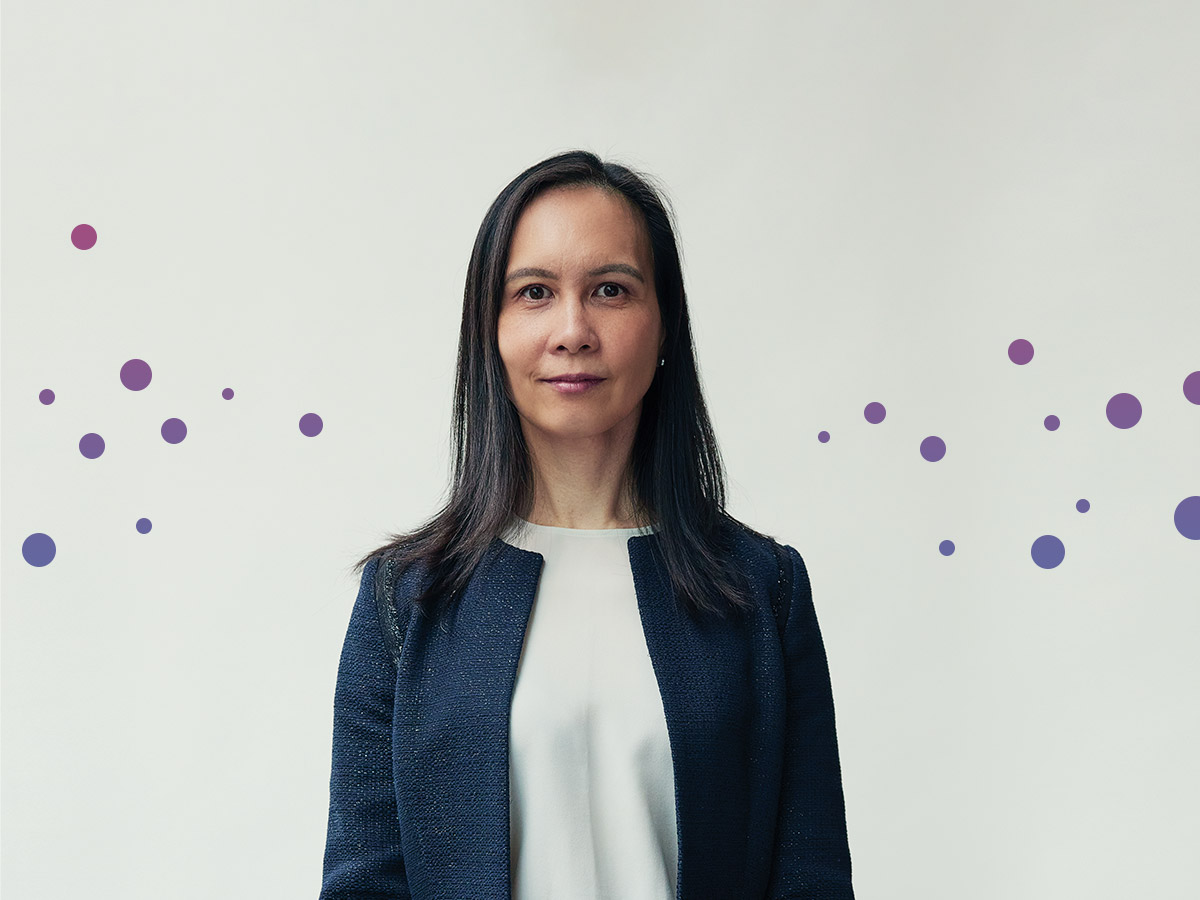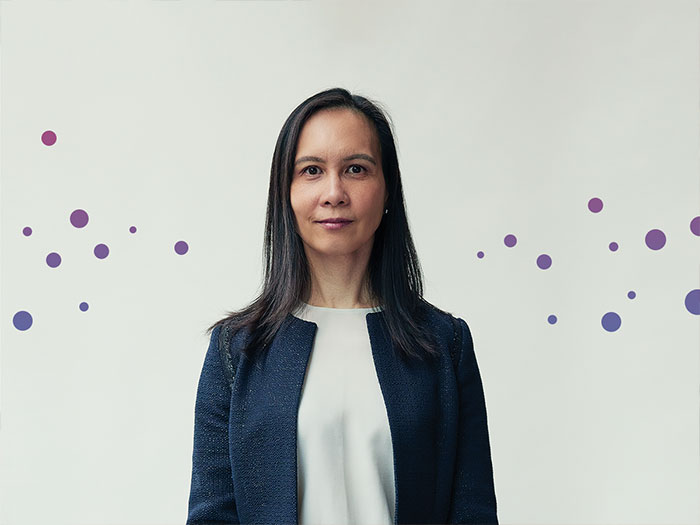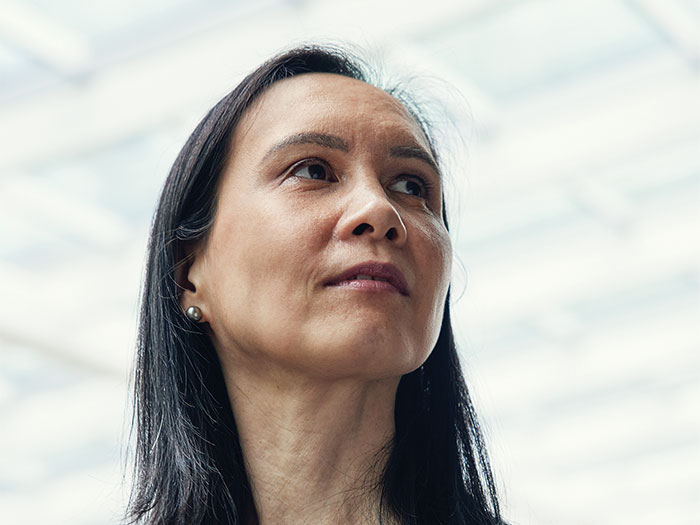
Meet the CPA helping entrepreneurs cash in on their ideas
 Lally Rementilla, a CPA and angel investor, recently joined BDC Capital to lead their IP-backed financing operation (Photograph by Daniel Ehrenworth)
Lally Rementilla, a CPA and angel investor, recently joined BDC Capital to lead their IP-backed financing operation (Photograph by Daniel Ehrenworth)
In late March, just nine days after the WHO declared a global pandemic, Justin Trudeau made an announcement while in self-isolation at Rideau Cottage. Canada, he promised, would rapidly scale up production of the life-saving supplies that health care workers desperately needed. There would be more masks, more gowns, more hand sanitizer. There would be COVID-19 test kits that delivered results in under an hour. And there would be extra ventilators, roughly 1,000 of them provided by Thornhill Medical, a medical tech company in Toronto.
Actually, Thornhill’s ventilators are more like portable ICUs: compact, battery-powered, capable of monitoring vital signs and delivering respiratory help with oxygen drawn from the air. Thornhill developed the devices more than a decade ago for the U.S. Marine Corps, which needed a lightweight platform to administer critical care in the field. By 2017, the company had secured customers in more than 30 countries and obtained dozens of patents for its technology. It was working on new products, like a mobile anesthesia unit and the first portable treatment device for carbon monoxide poisoning. But the sales cycle for these medical products is long, and each ventilator requires some 1,500 hard-to-source parts. At that time, the company urgently needed capital to grow. But Canada’s big banks tend to be hesitant about lending to businesses like Thornhill Medical—where much of the value comes not from the product but from the intellectual property.
Over the past four decades, a giant shift has taken place from the 20th-century production-based economy, in which goods were manufactured and sold, to a 21st-century knowledge-based economy, in which ideas are the primary commodity. It’s the difference between Walmart, which has stores and trucks and merchandise, and Google, which is now a verb. In 1970, for example, roughly a quarter of the American labour force held manufacturing jobs; by the early 2000s, that number fell to less than 10 per cent for the first time since the Industrial Revolution. In Canada, jobs at clothing manufacturers and textile mills dropped by nearly half between 2004 and 2008 alone. This evolution took place as the industrialized west discovered it was considerably cheaper to outsource its manufacturing to countries like China and India—and maintain its competitive advantage by generating new concepts instead, especially in the growing digital space. More than 90 per cent of the S&P 500 market value is now commanded by intangible assets like research, data, customer relationships, strategy, marketing and, crucially, intellectual property, or IP.
But ideas are hard to capture on a balance sheet, and banks must hold capital for the risks they take. It’s a lot easier for a company to secure a loan by offering collateral like its buildings, equipment or land. This sort of loan requires less capital from a bank: if the business goes belly up, the loss can be recouped by selling off those hard assets, which still have considerable value elsewhere. That’s trickier to do with intangible assets. There’s no single metric or agreed-upon methodology for determining how much they’re worth, nor is there a capital benefit for banks to use IP as security for loans. So most IP-rich firms find themselves out of luck.
 Researchers at Dalhousie University entered a partnership with Tesla to develop a battery. The company own the patent. (Daniel Ehrenworth)
Researchers at Dalhousie University entered a partnership with Tesla to develop a battery. The company own the patent. (Daniel Ehrenworth)
Lally Rementilla, however, believes you can put a price on IP. Until early 2020, Rementilla, a CPA and angel investor, ran Quantius, an alternative commercial lender in Toronto. The company funded knowledge-based companies with intangible assets, particularly small- and medium-sized ones. In fact, for Rementilla, IP-backed financing is a way of hedging—not courting—risk. “It’s our thesis that IP-rich companies have the unique portfolio, global customer base and strength to survive an economic downturn,” she says. “So we’re willing to put in the time to go very deep into understanding and appreciating their IP and intangible assets.”
That’s why, in 2017, Quantius provided Thornhill Medical with the financing it needed to launch three new products, more effectively source parts and make its supply chain more efficient. Bolstered by that success, Thornhill Medical secured Series A funding from a Shanghai-based private-equity firm the following year, and its revenue has since mushroomed by more than 800 per cent. By April 2020, in the middle of a global respiratory pandemic, they could deliver as many as 500 ventilators a month to hospitals across Canada. “Thornhill Medical proved our thesis,” Rementilla says. “They had resiliency in tough economic times and they’re being sought out all over the world for their innovation.”
Now, Rementilla is in a position to help many more companies achieve similar success. In May 2020, Quantius’s five-person team joined the Business Development Bank of Canada, a Crown corporation that has committed more than $36 billion to 62,000 entrepreneurs at various stages of development. Its investment arm, BDC Capital, wanted to unlock the potential of IP-rich companies that found themselves struggling to access capital and saw in Quantius a lender uniquely equipped to do just that. BDC Capital recently announced a $160-million fund to support knowledge-based companies across the country in the form of equity and debt. It’s a huge opportunity for IP in Canada. “Our mandate has always been to help Canadian companies grow,” Rementilla says. This partnership with the BDC gives them the reach to do that on a much bigger scale.
Rementilla knows the value of a well-timed influx of cash. Her mother was a trained pharmacist in Olongapo, a city two hours west of Manila, who harboured a dream of starting her own drug store. An investment from her mother-in-law allowed her to open one store, then several more, and then a travel agency as well. Rementilla’s grandmother was in a position to offer that initial capital because she had built a successful series of businesses, spinning a street-corner comic-book stand into a commercial real estate portfolio and a chain of gas stations. Rementilla remembers her grandmother personally hauling gas from the refinery, her truck barrelling through zigzag roads. “There’s a difference between a family business and a business family,” she says. “We’re a business family. A real sense of entrepreneurship was ingrained in our psyche.”
In 1990, the Rementillas left the Philippines for more political stability in Canada. Lally ended up at York University’s Schulich School of Business, where she completed her MBA part-time while working at the telecom-equipment company Lucent. In 2003, the same year she received her accounting certification, Rementilla joined the dating site Lavalife, eventually becoming the VP of finance and proving instrumental in its $180-million 2004 sale. Her time at Lavalife also gave her an appreciation for the challenges faced by a company—even a very lucrative company—that didn’t truck in hard assets. “Frequently, as head of finance, I would go to my bank and try to get a loan, and I felt like someone was always saying, ‘Lally, do you have a building? Do you have equipment?’ ” she recalls. “We had customers all over the world, we had a valuable intellectual property portfolio, but no one understood how we worked.”
She left Lavalife after eight years, serving as a board member of the Information Technology Association of Canada and launching Coco Capital, an angel investing practice geared toward female-led companies. In 2015, Rementilla joined Quantius as CFO, taking over as CEO four years later. She had a great deal of empathy for the loan-seekers who came through her office. “I have walked in the shoes of the companies we’re now financing,” says Rementilla, now the managing partner, intellectual property–backed financing at BDC Capital. “I know how hard it is to be fundraising all the time and how frustrating it is to be penalized because traditional lenders treat your assets differently.” And she wants to pull whatever cranks she can to help them focus on their growth.
 Rementilla received her accounting certification in 2003 (Photograph by Daniel Ehrenworth)
Rementilla received her accounting certification in 2003 (Photograph by Daniel Ehrenworth)
To do so, her team goes deep—very, very deep—into a company’s IP portfolio. They scrutinize every possible intangible asset to see what makes the company different, what makes them strong, what might protect them. By analyzing patents around the world, for example, Rementilla and her team can identify a company’s direct competitors, plus emerging competitors who might pose a threat in the next year or two, as well as possible revenue streams from patent infringement. They can find opportunities for partnerships or licensing agreements. They can see risks from a litigious field. They can even determine if a company is a little too innovative; sometimes, Rementilla says, there’s danger in being first out of the gate. “That might mean the market isn’t there yet. The uniqueness of IP isn’t the only thing that drives success.”
And after the valuation is finally made, it’s done again and again. After all, once the team lends against an intangible asset, they want to make sure that asset grows over time. Among Quantius’s past investments: the touchscreen tech startup Baanto International, the pharmaceuticals company Acerus and the e-learning software firm Lambda Solutions—which looks like a gangbuster bet now that millions of school kids are studying from home.
It’s time-consuming work that demands a well-rounded valuation skill set, which is hard to find at a lending institution. In fact, it was hard to find at the BDC. When he was setting up the bank’s nascent IP-backed financing initiative, BDC Capital executive VP Jérôme Nycz looked for that particular talent among the bank’s 2,400 employees, but couldn’t find what he needed. At the start of 2020, the BDC had discussions to invest in a fund led by Quantius, and found that they liked the team. “I said to Lally, you’ve got a high-performing team, but your challenge is access to capital. I’ve got the capital but I don’t have the team,” he says. Partnering up proved to be an elegant solution. Now Rementilla’s team will help BDC Capital nurture IP development across Canada through a series of $3- to $10-million loans.
By investing in a business, Rementilla says, the bank will send a strong signal that a particular company has hugely promising IP, spurring other private- and public-sector funders to back IP-rich companies. “That is how you create a healthy ecosystem for innovation,” she says.
The new knowledge economy is the difference between Walmart, which has stores and merchandise, and Google, which is now a verb.
Talk long enough to a Canadian IP expert and sooner or later they’ll bring up the Tesla battery. In 2016, researchers at Dalhousie University in Halifax inked an exclusive five-year research partnership with Elon Musk’s electric car company. Last September, they announced they’d developed a battery that would propel each vehicle for more than a million miles—twice the distance the cars currently get from their battery pack. The prestige belongs to the researchers, sure. But the patent belongs to Tesla.
How did this happen? Canada has fallen behind on protecting IP with patents—the essential tools for commercializing our innovation. It’s been easy for entrepreneurs and academics to assume that IP isn’t a priority. In fact, at universities across the country, IP is frequently considered something you could trade away, since the government often doles out funding for research based on how many graduate students can be trained or papers published. “Then Tesla comes knocking and says we want this research and will give you millions of dollars to do it, and you’ll get all sorts of grad students and publications out of it,” says Myra Tawfik, professor of law and intellectual property commercialization and strategy at the University of Windsor. For an academic institution, that sounds like a pretty good trade. So Google funds the AI research emerging from the University of Toronto’s Vector Institute. Huawei commits $50 million to more than a dozen Canadian universities to develop ultra-fast wireless technology.
In exchange, any intellectual property that springs from the research belongs to the company—even though that IP can be worth infinitely more than the initial funding. “Tesla obviously needs those batteries,” says Shiri Breznitz, associate professor at U of T’s Munk School of Global Affairs and Policy. “But we don’t benefit from our research because we don’t protect it properly.” Instead, with the patent safely in Tesla’s California-based hands, the wealth generated from that million-mile battery flows out of Canada and into the States. And we know that IP-rich companies add a great deal to a country’s economy: they have up to 10 times the revenue of businesses without intellectual property, they pay their employees salaries that are 16 per cent higher and they’re 64 per cent more likely to be high-growth.
Other countries have long invested in IP literacy and resources: the Korea Invention Promotion Association, for example, offers a three-day, all-expenses-paid training program in Seoul for business to learn the ins and outs of IP. The United States Patent and Trademark Office provides pro bono legal services for inventors. The U.K.’s Intellectual Property Office developed a curriculum for elementary students as young as five through an age-appropriate IP resource called Cracking Ideas. Canada, at last, seems to be catching up.
In 2018, the federal government launched an IP strategy that has since expanded to include a patent collective (which helps small- and medium-sized enterprises purchase and hold onto patents), a crackdown on patent trolls (who come after innovative companies for licensing income); inexpensive IP legal clinics for entrepreneurs held at Canadian law schools; and Indigenous IP initiatives that explore how IP interacts with traditional knowledge.
Then there’s the BDC’s $160-million initiative—and, just as important, the message it sends. This isn’t an innovation fund or a tech fund. It zeroes in specifically on IP itself. “When you have a bank, a Crown corporation, putting significant money into companies that are focused on IP, it shows that IP obviously matters,” Tawfik says. And it might inspire others to follow suit. Rementilla has been busy speaking with various stakeholders, from Innovation Canada to the National Research Council of Canada to the Trade Commissioner Service, to shore up more support to help innovative Canadian companies grow and compete around the world. “We don’t want to just do this ourselves—we want to bring together an entire ecosystem,” she says. “That becomes the rocket ship.”
SMALL BUSINESS RESOURCES
Learn more about key topics, from financial statement basics to effective financial management, and the many supports available. Also, refer to resources developed by the Business Development Bank of Canada to help improve your business.